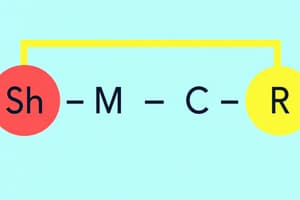Podcast
Questions and Answers
In the Shannon-Weaver model of communication, what is the role of the receiver?
In the Shannon-Weaver model of communication, what is the role of the receiver?
- To add noise to clarify the message.
- To formulate the initial message.
- To encode the message upon receiving it. (correct)
- To transmit the message without alteration.
Which aspect is NOT a component of every message in the Communication Square Model?
Which aspect is NOT a component of every message in the Communication Square Model?
- The relationship cue.
- The entertainment value. (correct)
- The appeal.
- The factual content.
What distinguishes the Transactional Model of Communication from earlier models?
What distinguishes the Transactional Model of Communication from earlier models?
- It incorporates simultaneous, two-way communication. (correct)
- It focuses on one-way communication.
- It emphasizes the role of a single sender.
- It limits the impact of cultural contexts.
In White's Model of Communication, what immediately follows the 'Decoding' stage?
In White's Model of Communication, what immediately follows the 'Decoding' stage?
According to Leagans' model, what is the role of 'treatment' in communication?
According to Leagans' model, what is the role of 'treatment' in communication?
How does Berlo's SMCR model account for cultural differences in communication?
How does Berlo's SMCR model account for cultural differences in communication?
What is a key focus of Lasswell's model of communication?
What is a key focus of Lasswell's model of communication?
According to Aristotle's model, what is the speaker's primary goal?
According to Aristotle's model, what is the speaker's primary goal?
What unique aspect does the Barnlund Transactional Model introduce to the understanding of communication?
What unique aspect does the Barnlund Transactional Model introduce to the understanding of communication?
In the Toulmin Method of argumentation, what serves to justify the evidence to the claim?
In the Toulmin Method of argumentation, what serves to justify the evidence to the claim?
Flashcards
Shannon-Weaver Model
Shannon-Weaver Model
A linear communication model where the sender encodes, sends a message through a channel, and the receiver decodes. It lacks feedback.
Communication Square Model
Communication Square Model
A communication model highlighting that every message has four aspects: factual content, self-revelation, relationship cue, and appeal.
Transactional Model
Transactional Model
A two-way, interactive communication model where both sender and receiver are responsible for effective communication and exchange messages simultaneously.
Leagans Model
Leagans Model
Signup and view all the flashcards
Interaction Model
Interaction Model
Signup and view all the flashcards
Berlo's SMCR Model
Berlo's SMCR Model
Signup and view all the flashcards
Aristotle's Model
Aristotle's Model
Signup and view all the flashcards
Monroe's Motivated Sequence
Monroe's Motivated Sequence
Signup and view all the flashcards
Toulmin Method
Toulmin Method
Signup and view all the flashcards
Study Notes
- Communication involves encoding and decoding verbal and nonverbal cues, along with real-time feedback.
- Communication constructs social realities based on social, relational, and cultural contexts.
Shannon-Weaver Communication Model
- The Shannon-Weaver model communication involves a sender encoding a message that goes through a channel to the receiver, who then decodes it.
- The model is linear and lacks feedback.
- The Shannon-Weaver model was the first communication model, proposed in 1949 for Bell Laboratories.
- Claude Elwood Shannon and Warren Weaver are known as the "Mother of Linear Model of Communication"
Communication Square Model
- The Communication Square Model was developed by Friedemann Schulz von Thun.
- The model states every message has four sides: factual content, self-revelation, relationship cue, and appeal.
- These aspects occur simultaneously to prevent misunderstanding and improve communication.
Transactional Model of Communication
- Dean C. Barnlund created the Transactional Model of Communication.
- The Transactional Model is a two-way interactive model where communication occurs simultaneously in both directions.
- Both the sender and receiver are responsible for effective communication.
White's Model of Communication
- White's Model of Communication consists of eight sequences of events starting with stimulation, encoding, transmission, reception, decoding, recognition, interpretation, and response/feedback.
- The purpose of White's Model is to achieve effective communication, share information, influence and persuade, build relationships, and guide decision-making.
Leagan's Model
- Leagan (1961) defines communication as exchanging ideas, facts, feelings, and impressions to gain a clear understanding of the message.
- Leagan's Model shows how successful communication requires a skilled communicator sending a useful message through a proper channel to an appropriate audience.
Wilbur Schramm's Interaction Model
- Schramm (1954) described communication as sharing information where the sender and receiver actively exchange messages and feedback through physical and psychological contexts.
- The elements of communication include the sender, receiver, message, channel, feedback, knowledge field, and physical contexts.
- The purpose of the model is to have active participation in the communication process.
Berlo's SMCR Model
- David Berlo (1960) emphasized components of the communication process.
- SMCR stands for Source, Message, Channel, and Receiver.
- Source is where information originates; the one responsible for transferring information.
- Message is the substance sent to the receiver.
- Channel is the medium used to transmit the message.
- Receiver should be on the same platform as the speaker for smoother communication.
- Context and social and cultural settings are important factors in how messages are sent and received.
De Fleur Model of Communication
- Melvin Lawrence De Fleur created the De Fleur Model of Communication.
- Communication is a two-way, cyclical process, where the sender creates the message and chooses what to communicate.
- The message is composed of information to be conveyed and can be written, spoken, nonverbal, or symbolic.
- The channel is the medium to send the message.
- Feedback is the reaction of the sender to the recipient.
Lasswell's Model of Communication
- Harold Lasswell, a political scientist, believes there are certain questions that communication must answer.
- The model follows a linear pattern.
- Benefits mostly advertising, public relations, marketing and consumer behavior, and mass communication.
- The purpose is to assess the effect and impact of communication.
Aristotle's Communication Model
- Aristotle emphasized the importance of the speaker, message, and audience, with persuasion as the speaker's primary goal.
- The Aristotle model is linear and lacks feedback.
Barnlund's Transactional Model
- Dean Barnlund (1970) presents a layered feedback system where all parties can be senders and receivers simultaneously.
- Layers of feedback contain verbal and non-verbal cues.
- The model depicts shared field experience between sender and receiver and conveys sendings, noise and feedback simultaneously.
- Critics view it as the most systematic communication model, encompassing factors like person, decoding/encoding, public/private cues, and nonverbal cues.
- The model describes a circular process where senders and receivers influence the shared message.
Westley and MacLean Model
- Bruce Westley and Malcolm MacLean suggest the communication process starts with environmental factors.
- The difference between interpersonal communication and mass communication is the feedback, which is indirect and slow for mass communication.
Monroe's Motivated Sequence
- Alan Monroe developed the Monroe's Motivated Sequence to persuade an audience by structuring presentations to encourage action.
- The system involves grabbing attention, highlighting a problem, presenting a solution, visualizing benefits, and encouraging action.
Toulmin Method
- Stephen Toulmin developed the Toulmin Model as a framework for logically analyzing and constructing arguments.
- The Toulmin Method breaks arguments down into:
- Claim: the main point/conclusion
- Grounds: the evidence
- Warrant: the underlying assumption
- Qualifier: The degree of certainty
- Rebuttal: The counter argument/ objections
- Backing: Additional support for the warrant
Studying That Suits You
Use AI to generate personalized quizzes and flashcards to suit your learning preferences.




